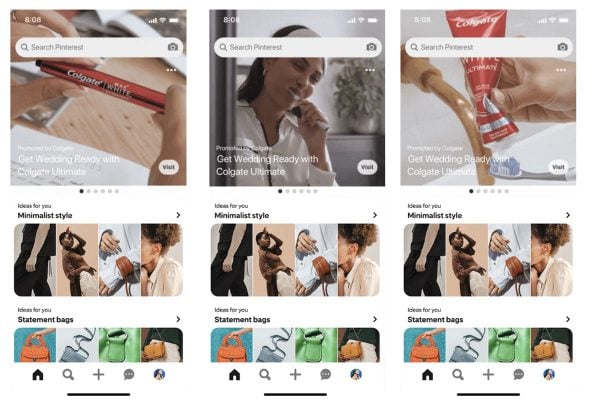The move by Instagram, Google and Pinterest into become quasi-marketplace platforms seems to be a canny one – shoppers are embracing social commerce with alacrity.
According to a study by Curalate, two thirds of consumers in the UK go on to purchase products they discover on retailer social media sites, while a second study by Bazaarvoice finds that visual content shared via social media on mobile produces as much as a 111% uplift in conversion and can generate 180% boost in revenue per visitor.
Looking at 1000 consumers aged 16 to 35, Curalate found that that 18-34 year olds are much more receptive to shoppable social posts, with half of them saying they are interested in learning more about items they see on social sites.
Overall, 39% of consumers were influenced by user generated content, saying real life images of people who had previously bought the product would make them more likely to make a purchase.
When asked about following brands on social media, Curalate’s research found that 45% of female respondents did so, compared with 38% of males. Over half (56%) of 18-34 year olds engaged with brands on social channels, against 21% of 55-65 year olds
Meanwhile, a third of the sample said they would shop directly on a brand’s Facebook, Instagram, Twitter and Pinterest pages if they could use an easy payment system where their information was already saved.
“Buying through social media is a growing trend, as more consumers become interested in following and interacting with brands via these channels. The influence of customer and lifestyle content on retail sales presents an opportunity for brands to monetise this environment in a coherent way, where shoppers are able to purchase the products they see at the point of discovery. Our research found that almost a quarter (24%) will make a purchase if they are taken directly to a product on the retailer’s website, rather than having to search for it.”
– Apu Gupta, CEO and co-founder, Curalate
Meanwhile, the Bazaarvoice research finds that visual content shared on social media is driving huge sales growth – with potential for more as retailers and brands invest in this side of their business.
Studying how consumers are engaging and interacting with more than 2,600 websites in the Bazaarvoice Network of brand and retailer domains, the company found that despite a growing trend in voice commerce for reordering things, social visual content is going to be increasingly vital in the consumer experience aspects of retail.
Brands and retailers are therefore turning to more visual content to improve the shopping experience. According the client survey, 80% say visual CGC increases discoverability of products and they either have visual CGC or plan to implement in the next year. Nearly nine in ten (88%) say visual CGC improves brand trust.
As a result 47% of brands and retailers say being able to discover and buy products from social media channels such as Instagram will be more important to shoppers in the next year, and 23% say being able to discover and buy products on social media will be a significant differentiator in the next year.
“The average consumer spends two hours a day on social media platforms, and visual customer generated content acts as a powerful conduit between social platforms and e-commerce. Consumers have embraced features such as shoppable social content, and are coming to expect scrollable galleries of product and lifestyle content alongside the online shopping experience.”
– Joe Rohrlich, EVP and general manager EMEA, Bazaarvoice
These two pieces of research add credence to the moves by Pinterest and Instagram in the past months where they have both upped the ante in how they offer the ability to businesses to sell through their platforms. While the research by both Bazaarvoice and Curalate looks at how consumers interact with retailer and brand social media content – and UGC created therein – it points the way to how social media sites are an excellent way to market goods to consumers, offering perhaps better conversion rates than almost any other channel. Adding the ability to sell from them makes them potentially a credible alternative marketplace to the likes of Amazon – driven by discovery rather than search.
Of course, this isn’t the end of Amazon or eBay, but platforms that can market, offer independent influence and visual content for discovery of goods are going to change the retail paradigm in the years ahead.







